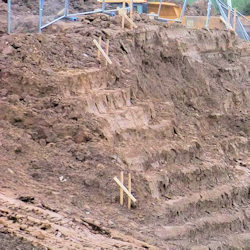Sloping and Benching Problems
Although sloping and benching is a good method for excavations, there are still some problems you may encounter.
For example wide excavation areas can:
- expose footings or cause damage to the walls of the adjacent structure and pose additional hazards to employees;
- expose or place utilities (such as electrical power, water, and gas lines) above the angle for a safe slope; and
- cause damage from the movement of the equipment across a larger excavation.
To prevent the collapse of an unsupported bench in an excavation 8 feet or less in depth, the allowable height of a bench at the base of an excavation must be 3 1/2 feet or less. A common hazard in a multiple-benched excavation is the collapse of one bench into a lower bench.
Preparing to Slope or Bench
Before the start of sloping or benching, the contractor needs to:
- determine soil types at the excavation site using the soil classification system;
- consider potential sloping and benching problems; and
- identify all protective measures necessary to ensure safe working conditions, and
- determine which protection method is the best to use at the site.
Knowledge Check Choose the best answer for the question.
4-4. What is a common hazard when multiple benches have been created for an excavation?
You forgot to answer the question!

